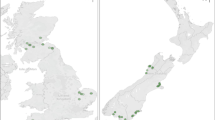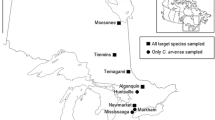Abstract
Norway maple (Acer platanoides) is a Eurasian introduced tree species which has invaded the North American range of its native congener, sugar maple (A. saccharum). One hypothesis used to explain the success of an invasive species is the enemy release hypothesis (ERH), which states that invasive species are often particularly successful in their new range because they lack the enemies of their native range. In this study, we hypothesized that Norway maple would have less insect damage than sugar maple due to such enemy release. Autumn 2005 and summer 2006 leaves of Norway and sugar maple were collected from six sites in New Jersey and Pennsylvania to compare percent leaf area loss, gall damage, fungal damage, and specific leaf area (cm2/g). Although both species had low overall mean levels of leaf damage (0.4–2.5%), in both years/seasons Norway maple had significantly less leaf damage than sugar maple. Insects were also collected to compare insect assemblies present on each tree species. The numbers of insect taxa and individuals found on each species were nearly equivalent. Overall, the results of this study are consistent with the enemy release hypothesis for Norway maple. In addition, sugar maples when surrounded by Norway maples tended to show reduced herbivory. This suggests that the spread of Norway maple in North America, by reducing amounts of insect herbivory, may have further ecosystem-wide impacts.




Similar content being viewed by others
References
Adams JM, Fung W, Sullivan R, Cipollini D, TRAIN members (2008). Norway maple (Acer platanoides L.) has three times as much herbivory in its native range in Europe as in its introduced range in North America. Biol Invasions (in press)
Agrawal AA, Kotanen PM (2003) Herbivores and the success of exotic plants: a phylogenetically controlled experiment. Ecol Lett 6:712–715
Agrawal AA, Kotanen PM, Mitchell CE, Power AG, Godsoe W, Klironomos JN (2005) Enemy release? An experiment with congeneric plant pairs and diverse above- and belowground enemies. Ecology 86:2979–2989
Aldea M, Hamilton JG, Resti JP, Zangerl AR, Berenbaum MR, DeLucia EH (2005) Indirect effects of insect herbivory on leaf gas exchange in soybean. Plant Cell Environ 28:402–411
Atsatt PR, O’Dowd DJ (1976) Plant defense guilds. Science 93:24–29
Bentley S, Whittaker JB, Malloch AJC (1980) Field experiments on the effects of grazing by a Chrysomelid beetle (Gastrophysa viridula) on seed production and quality in Rumex obtusifolius and Rumex crispus. J Ecol 68:671–674
Borror DJ, White RE (1970) Peterson field guides: insects. Houghton Mifflin Company, New York
Brown VK, Lawton JH, Grubb PJ (1991) Herbivory and the evolution of leaf size and shape [and discussion]. Philos Trans R Soc Lond Biol Sci 333(1267):265–272
Colautti RI, Ricciardi A, Grigorovich IA, MacIsaac HJ (2004) Is invasion success explained by the enemy release hypothesis? Ecol Lett 7:721–733
Crawley MJ (1983) Herbivory, the dynamics of animal–plant interactions. Blackwell, Oxford
DeWalt SJ, Denslow JS, Ickes K (2004) Natural enemy release facilitates habitat expansion of the invasive tropical shrub Clidemia hirta. Ecology 85:471–483
Dietz H, Wirth LR, Buschmann H (2004) Variation in herbivore damage to invasive and native woody plant species in open forest vegetation on Mahe, Seychelles. Biol Invasions 6:511–521
Elton CS (1958) The ecology of invasions by animals and plants. Chapman and Hall, London, England
Hjalten J, Price PW (1997) Can plants gain protection from herbivory by association with unpalatable neighbors? A field experiment in a willow-sawfly system. Oikos 78(2):317–322
Huntly N (1991) Herbivores and the dynamics of communities and ecosystems. Ann Rev Ecol Syst 22:477–503
Janzen DH (1970) Herbivores and the number of tree species in tropical forests. Am Nat 104:501–527
Jones CG, Lawton JH (1991) Plant chemistry and insect species richness of British umbellifers. J Anim Ecol 60:767–777
Jongejans E, Sheppard AW, Shea K (2006) What controls the population dynamics of the invasive thistle Carduus nutans in its native range? J Appl Ecol 43(5):877–886
Keane RM, Crawley MJ (2002) Exotic plant invasions and the enemy release hypothesis. Trends Ecol Evol 17:164–170
Kloeppel BD, Abrams MD (1995) Ecophysiological attributes of the native Acer saccharum and the exotic Acer platanoides in urban oak forests in Pennsylvania, USA. Tree Physiol 15:739–746
Larson CL (1998) The impact of two gall-forming arthropods on the photosynthetic rates of their hosts. Oecologia 115:161–166
Lei TT, Lechowicz MJ (1998) Diverse responses of maple seedlings to forest light regimes. Ann Bot 82:9–19
Liu H, Stiling P, Pemberton RW (2007) Does enemy release matter for invasive plants? Evidence from a comparison of insect herbivore damage among invasive, non-invasive and native congeners. Biol Invasions 9:773–781
Lopes DB, Berger RD (2001) The effects of rust and anthracnose on the photosynthetic competence of diseased bean leaves. Phytopathology 91:212–220
Lowman MD, Heatwole H (1992) Spatial and temporal variability in defoliation of Australian eucalypts. Ecology 73(1):129–142
Martin PH (1999) Norway maple (Acer platanoides) invasion of a natural forest stand: understory consequence and regeneration pattern. Biol Invasions 1:215–222
Meiners SJ (2005) Seed and seedling ecology of Acer saccharum and Acer platanoides: a contrast between native and exotic congeners. North East Nat 12:23–32
Meiners SJ, Handel SN, Pickett STA (2000) Tree seedling establishment under insect herbivory: edge effects and interannual variation. Plant Ecol 151:161–170
Mitchell CE, Power AG (2003) Release of invasive species and fungal and viral pathogens. Nature 421:625–627
Nowak DJ, Rowntree RA (1990) History and range of Norway maple. J Arboriculture 16:291–296
Nykanen H, Koricheva J (2004) Damage-induced changes in woody plants and their effects on insect herbivore performance: a meta-analysis. Oikos 104:247–268
Reinhart KO, Callaway RM (2004) Soil biota facilitate exotic Acer invasions in Europe and North America. Ecol Appl 14:1737–1745
Rose AH, Lindquist OH (1982) Insects of eastern hardwood trees. Canadian Government Publishing Centre, Hull, Quebec, Canada
Webb SL, Kaunzinger CK (1993) Biological invasion of the Drew University (New Jersey) Forest Preserve by Norway maple (Acer platanoides L.). Bull Torey Bot Club 120:343–349
Webb SL, Dwyer M, Kaunzinger CK, Wyckoff PH (2000) The myth of the resilient forest: case study of the invasive Norway maple (Acer platanoides). Rhodora 102:332–354
Webb SL, Pendergast TH, Dwyer ME (2001) Response of native and exotic maple seedling banks to removal of the exotic, invasive Norway maple (Acer platanoides). J Torrey Bot Soc 128:141–149
Whittaker JB, Warrington S (1985) An experimental field study of different levels of insect herbivory induced by Formica rufa predation on Sycamore (Acer pseudoplatanus) III. Effects on tree growth. J Appl Ecol 22:797–811
Wolfe LM (2002) Why alien invaders succeed: support for the escape-from-enemy hypothesis. Am Nat 160:705–711
Wychoff PH, Webb SL (1996) Understory influence of the invasive Norway maple (Acer platanoides). Bull Torrey Bot Soc 123:197–205
Zangerl AR, Hamilton JG, Miller TJ, Crofts AR, Oxborough K, Berenbaum MR, de Lucia EH (2002) Impact of folivory on photosynthesis is greater than the sum of its holes. Proc Natl Acad Sci 99(2):1088–1091
Acknowledgements
We would like to thank Sara Webb (Drew University), Jose-Luis Machado (Swarthmore College), and Nora Wagner (Duke Farms) for providing access to sites used in this research. Thanks to Terry Malcolm for providing much needed guidance in the statistical aspect of this work and to Vincent Koczurik for assisting in insect identification. We would also like to thank Yangjian Zhang, Jack Chapman, Melanie Kaeser, and Mary Killilea, for their support and assistance.
Author information
Authors and Affiliations
Corresponding author
Rights and permissions
About this article
Cite this article
Cincotta, C.L., Adams, J.M. & Holzapfel, C. Testing the enemy release hypothesis: a comparison of foliar insect herbivory of the exotic Norway maple (Acer platanoides L.) and the native sugar maple (A. saccharum L.). Biol Invasions 11, 379–388 (2009). https://doi.org/10.1007/s10530-008-9255-9
Received:
Accepted:
Published:
Issue Date:
DOI: https://doi.org/10.1007/s10530-008-9255-9




